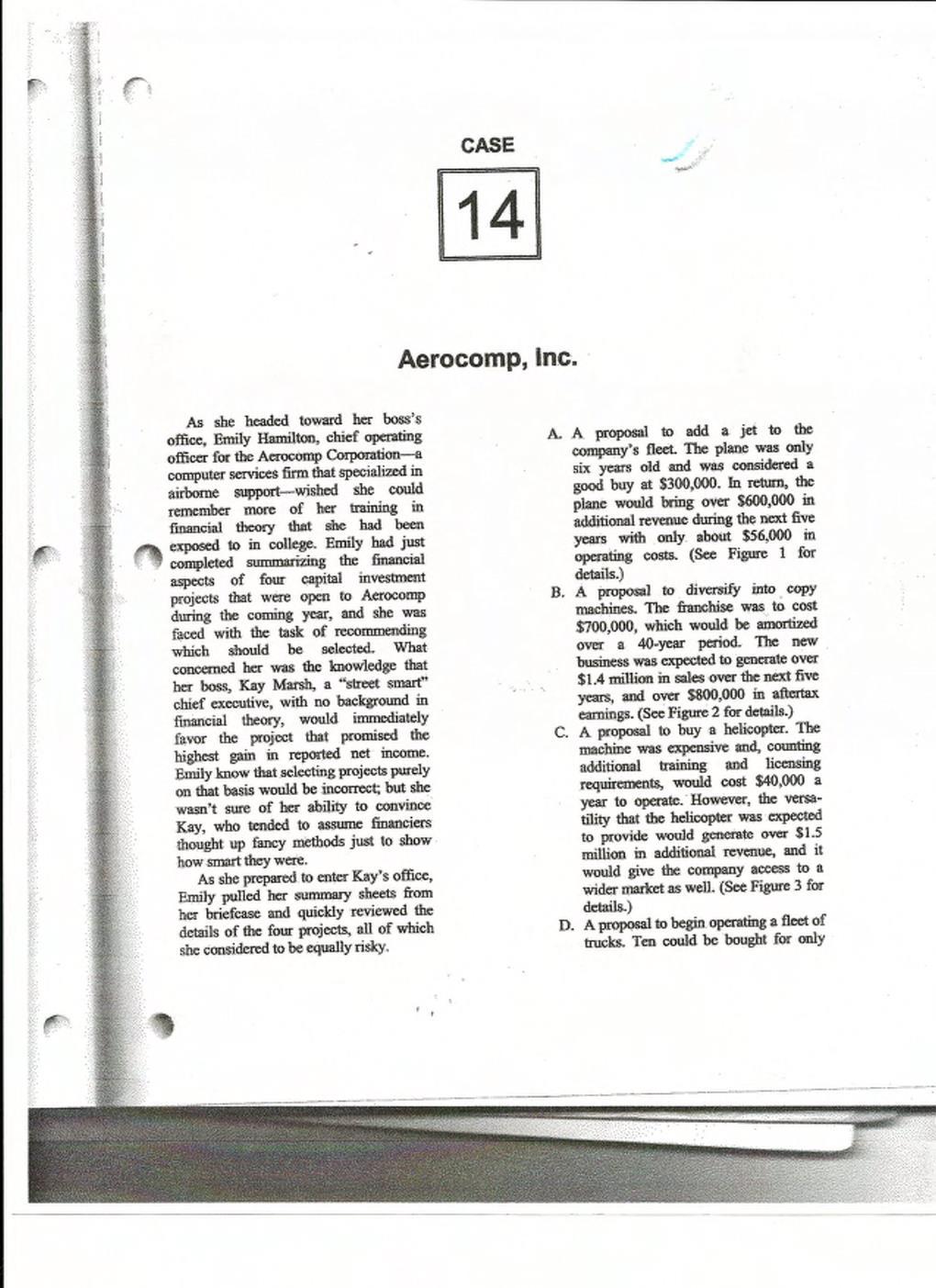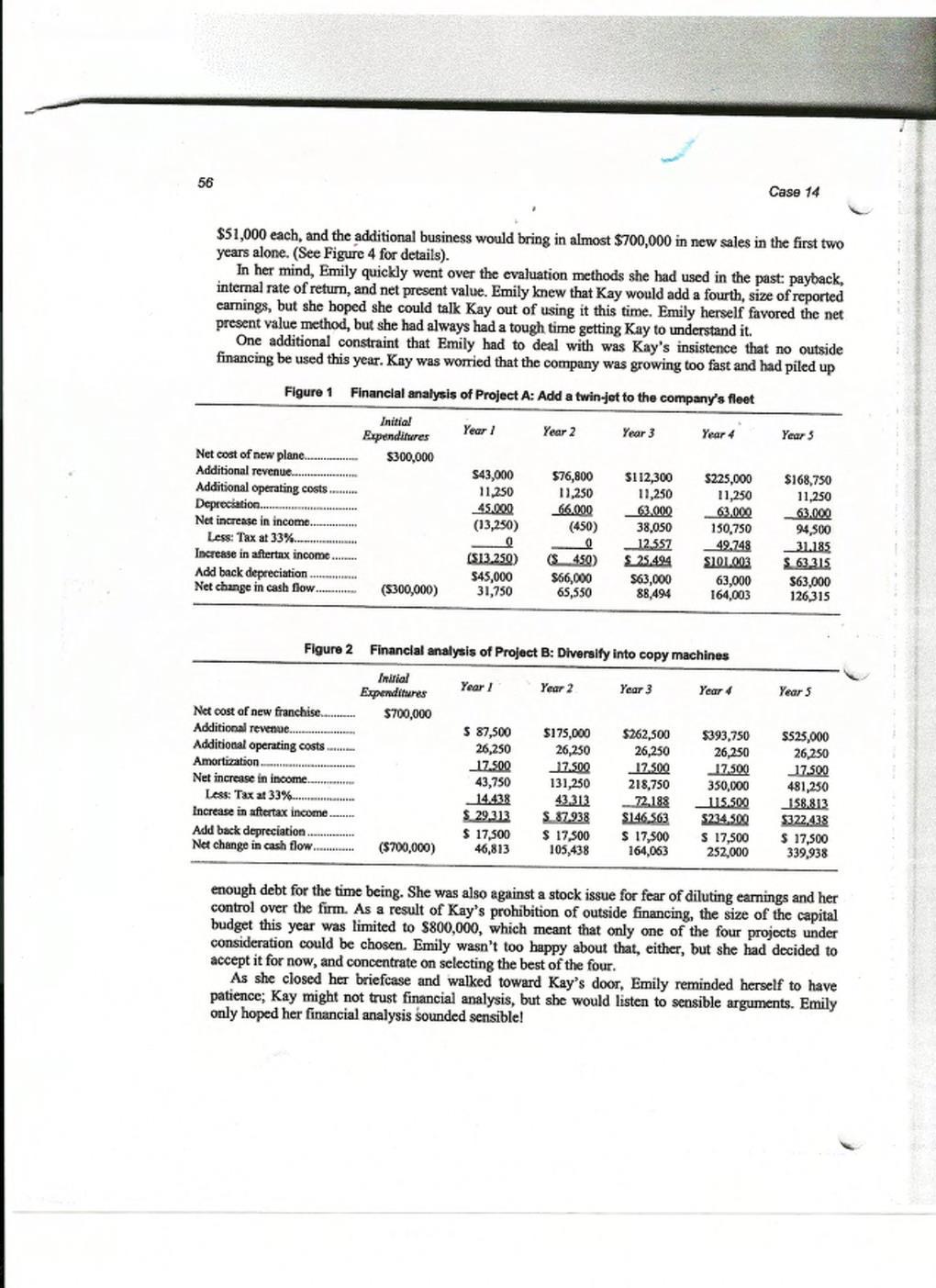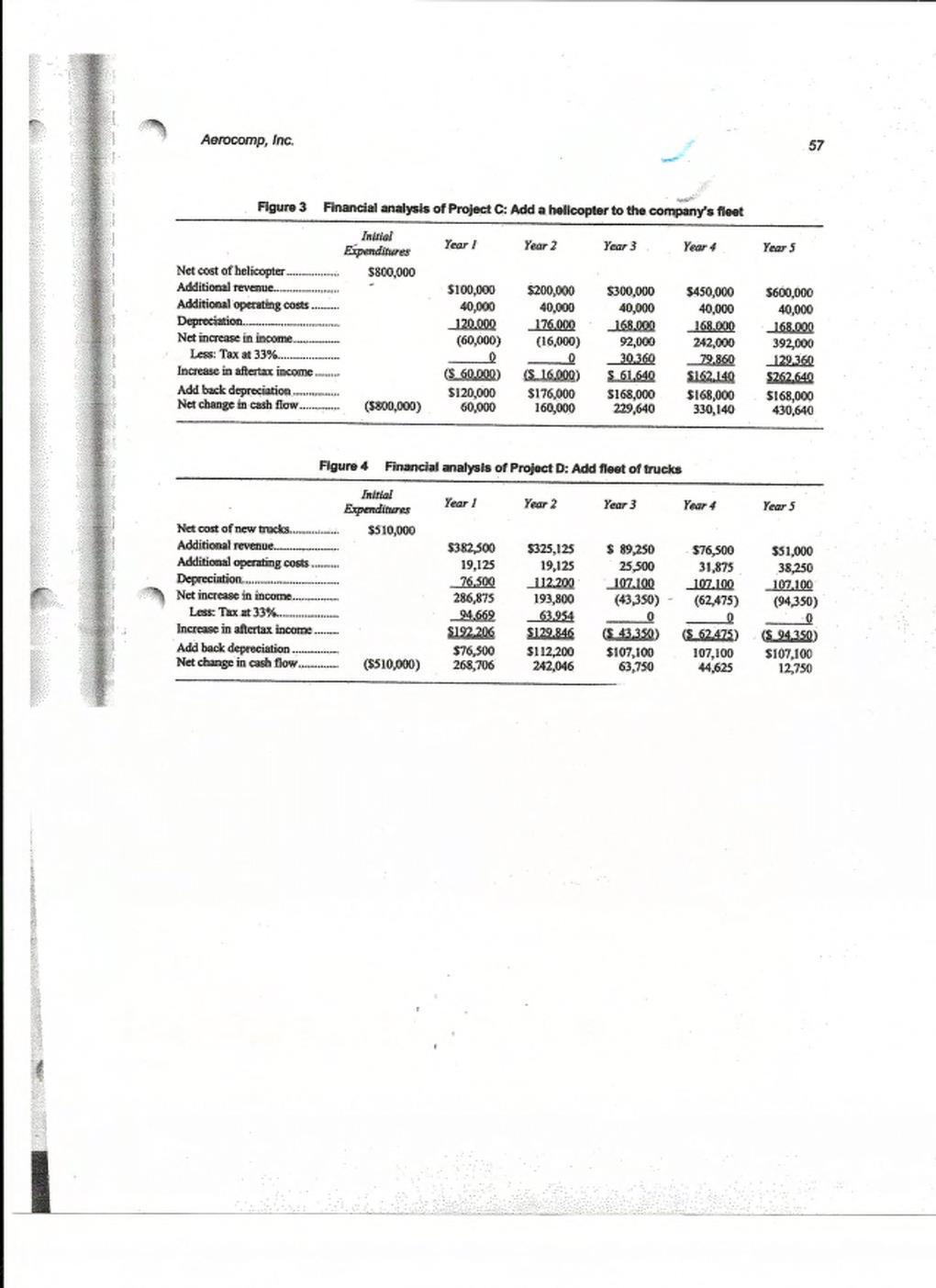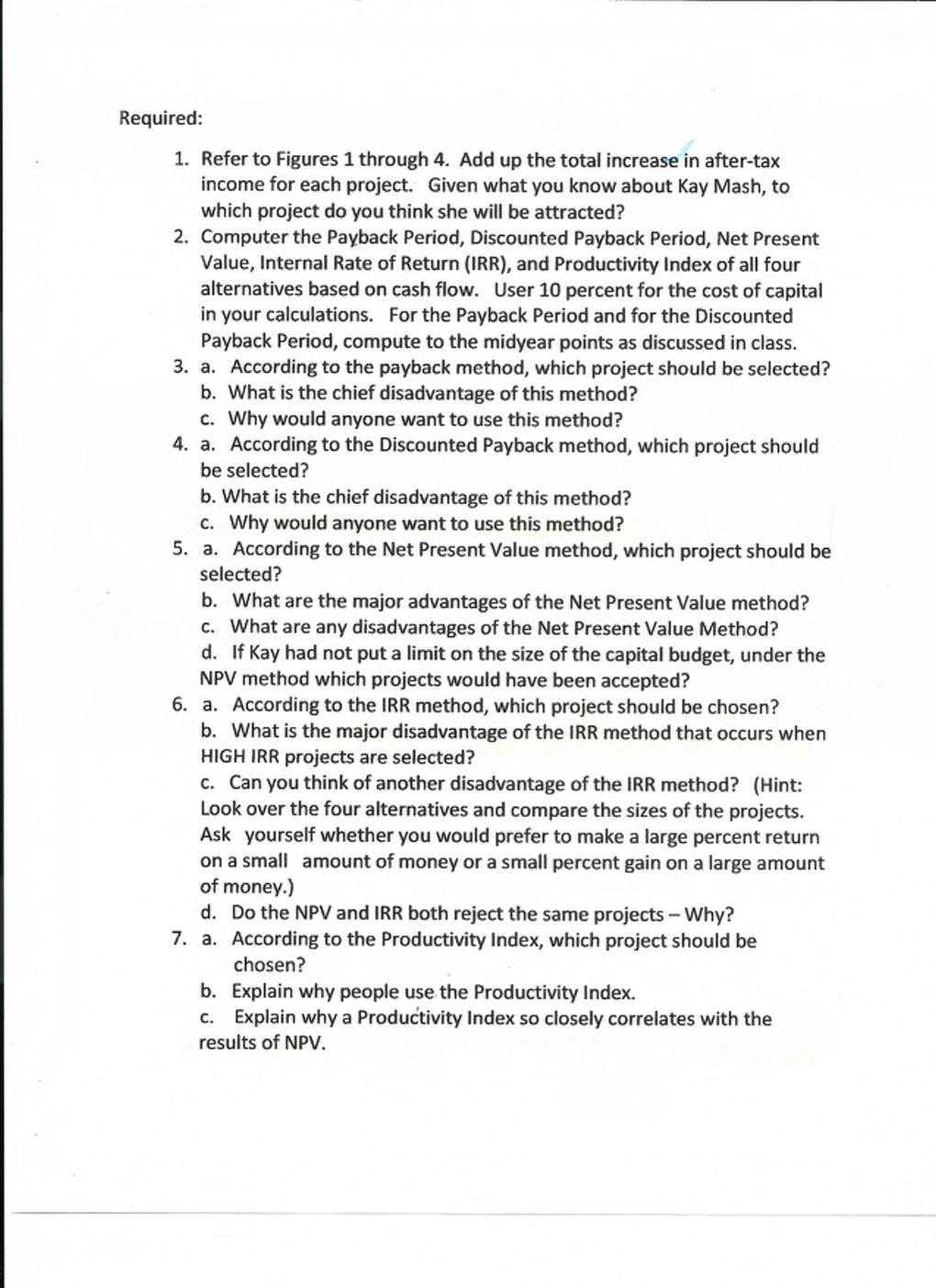Answered step by step
Verified Expert Solution
Question
1 Approved Answer
Answer Questions 6 and 7 please! Thank you. CASE 14 Aerocomp, Inc. As she headed toward her boss's office, Emily Hamilton, chief operating officer for




Answer Questions 6 and 7 please! Thank you.
CASE 14 Aerocomp, Inc. As she headed toward her boss's office, Emily Hamilton, chief operating officer for the Acrocomp Corporation- computer services firm that specialized in airborne support--wished she could remember more of her training in financial theory that she had been exposed to in college. Emily had just completed summarizing the financial aspects of four capital investment projects that were open to Aerocomp during the coming year, and she was faced with the task of recommending which should be selected. What concerned her was the knowledge that her boss, Kay Marsh, a "street smart" chief executive, with no background in financial theory, would immediately favor the project that promised the highest gain in reported net income. Emily know that selecting projects purely on that basis would be incorrect, but she wasn't sure of her ability to convince Kay, who tended to assume financiers thought up fancy methods just to show how smart they were. As she prepared to enter Kay's office, Emily pulled her summary sheets from her briefcase and quickly reviewed the details of the four projects, all of which she considered to be equally risky A. A proposal to add a jet to the company's fleet. The plane was only six years old and was considered a good buy at $300,000. In return, the plane would bring over $600,000 in additional revenue during the next five years with only about $56,000 in operating costs. (See Figure 1 for details.) B. A proposal to diversify into copy machines. The franchise was to cost $700,000, which would be amortized over a 40-year period. The new business was expected to generate over $1.4 million in sales over the next five years, and over $800,000 in aftertax earnings. (See Figure 2 for details.) C. A proposal to buy a helicopter. The machine was expensive and, counting additional training and licensing requirements, would cost $40,000 a year to operate. However, the versa- tility that the helicopter was expected to provide would generate over $1.5 million in additional revenue, and it would give the company access to a wider market as well. (See Figure 3 for details.) D. A proposal to begin operating a fleet of trucks. Ten could be bought for only Aerocomp, Inc. 57 Year 5 Figure 3 Financial analysis of Project C: Add a helicopter to the company's fleet Inicial Year! Expenditures Year 2 Year 3 Year 4 Net cost of helicopter ... $800,000 Additional revenue.. $100,000 $200,000 $300,000 $450,000 Additional operating costs......... 40,000 40,000 40,000 40,000 Depreciation. 120.000 176.000 168.000 168.000 Net increase in income. (60,000) (16,000) 92,000 242,000 Less: Tax at 33%......... D D 30.360 79.860 Increase in aftertax income... ($ 60,000) (S. 16.000) $.61.640 $162.149 Add back depreciation ..... $120,000 $176,000 S168,000 $168,000 Net change in cash flow........ (5800,000) 60,000 160,000 229,640 330,140 $600,000 40,000 168.000 392,000 129.360 $262.640 5168,000 430,640 Figure 4 Financial analysis of Project D: Add fleet of trucks Year 1 Year 2 Year 3 Year 4 Year 5 Initial Expenditures Net cost of new tracks. $510,000 Additional revenue. Additional operating costs..... Depreciation. Net increase in income...... Less: Tax at 33% Increase in aftertax income......... Add back depreciation Net change in cash flow......... ($510,000) $382,500 19,125 76,500 286,875 94.662 $192.206 $76,500 268,706 $325,125 19,125 112.200 193,800 63.954 $129,846 $112,200 242,046 $ 89,250 25,500 107.100 (43,350) 0 (543,350) $107,100 63,750 $76,500 31,875 107.100 (62,475) 0 (5.62475) 107,100 44.625 $51,000 38,250 107.100 (94,350) (S 94.350) S107,100 12,750 Required: 1. Refer to Figures 1 through 4. Add up the total increase in after-tax income for each project. Given what you know about Kay Mash, to which project do you think she will be attracted? 2. Computer the Payback Period, Discounted Payback Period, Net Present Value, Internal Rate of Return (IRR), and Productivity Index of all four alternatives based on cash flow. User 10 percent for the cost of capital in your calculations. For the Payback period and for the Discounted Payback Period, compute to the midyear points as discussed in class. 3. a. According to the payback method, which project should be selected? b. What is the chief disadvantage of this method? c. Why would anyone want to use this method? 4. a. According to the Discounted Payback method, which project should be selected? b. What is the chief disadvantage of this method? C. Why would anyone want to use this method? 5. a. According to the Net Present Value method, which project should be selected? b. What are the major advantages of the Net Present Value method? c. What are any disadvantages of the Net Present Value Method? d. If Kay had not put a limit on the size of the capital budget, under the NPV method which projects would have been accepted? 6. a. According to the IRR method, which project should be chosen? b. What is the major disadvantage of the IRR method that occurs when HIGH IRR projects are selected? C. Can you think of another disadvantage of the IRR method? (Hint: Look over the four alternatives and compare the sizes of the projects. Ask yourself whether you would prefer to make a large percent return on a small amount of money or a small percent gain on a large amount of money.) d. Do the NPV and IRR both reject the same projects - Why? 7. a. According to the Productivity Index, which project should be chosen? b. Explain why people use the Productivity Index. c. Explain why a Productivity Index so closely correlates with the results of NPV. CASE 14 Aerocomp, Inc. As she headed toward her boss's office, Emily Hamilton, chief operating officer for the Acrocomp Corporation- computer services firm that specialized in airborne support--wished she could remember more of her training in financial theory that she had been exposed to in college. Emily had just completed summarizing the financial aspects of four capital investment projects that were open to Aerocomp during the coming year, and she was faced with the task of recommending which should be selected. What concerned her was the knowledge that her boss, Kay Marsh, a "street smart" chief executive, with no background in financial theory, would immediately favor the project that promised the highest gain in reported net income. Emily know that selecting projects purely on that basis would be incorrect, but she wasn't sure of her ability to convince Kay, who tended to assume financiers thought up fancy methods just to show how smart they were. As she prepared to enter Kay's office, Emily pulled her summary sheets from her briefcase and quickly reviewed the details of the four projects, all of which she considered to be equally risky A. A proposal to add a jet to the company's fleet. The plane was only six years old and was considered a good buy at $300,000. In return, the plane would bring over $600,000 in additional revenue during the next five years with only about $56,000 in operating costs. (See Figure 1 for details.) B. A proposal to diversify into copy machines. The franchise was to cost $700,000, which would be amortized over a 40-year period. The new business was expected to generate over $1.4 million in sales over the next five years, and over $800,000 in aftertax earnings. (See Figure 2 for details.) C. A proposal to buy a helicopter. The machine was expensive and, counting additional training and licensing requirements, would cost $40,000 a year to operate. However, the versa- tility that the helicopter was expected to provide would generate over $1.5 million in additional revenue, and it would give the company access to a wider market as well. (See Figure 3 for details.) D. A proposal to begin operating a fleet of trucks. Ten could be bought for only Aerocomp, Inc. 57 Year 5 Figure 3 Financial analysis of Project C: Add a helicopter to the company's fleet Inicial Year! Expenditures Year 2 Year 3 Year 4 Net cost of helicopter ... $800,000 Additional revenue.. $100,000 $200,000 $300,000 $450,000 Additional operating costs......... 40,000 40,000 40,000 40,000 Depreciation. 120.000 176.000 168.000 168.000 Net increase in income. (60,000) (16,000) 92,000 242,000 Less: Tax at 33%......... D D 30.360 79.860 Increase in aftertax income... ($ 60,000) (S. 16.000) $.61.640 $162.149 Add back depreciation ..... $120,000 $176,000 S168,000 $168,000 Net change in cash flow........ (5800,000) 60,000 160,000 229,640 330,140 $600,000 40,000 168.000 392,000 129.360 $262.640 5168,000 430,640 Figure 4 Financial analysis of Project D: Add fleet of trucks Year 1 Year 2 Year 3 Year 4 Year 5 Initial Expenditures Net cost of new tracks. $510,000 Additional revenue. Additional operating costs..... Depreciation. Net increase in income...... Less: Tax at 33% Increase in aftertax income......... Add back depreciation Net change in cash flow......... ($510,000) $382,500 19,125 76,500 286,875 94.662 $192.206 $76,500 268,706 $325,125 19,125 112.200 193,800 63.954 $129,846 $112,200 242,046 $ 89,250 25,500 107.100 (43,350) 0 (543,350) $107,100 63,750 $76,500 31,875 107.100 (62,475) 0 (5.62475) 107,100 44.625 $51,000 38,250 107.100 (94,350) (S 94.350) S107,100 12,750 Required: 1. Refer to Figures 1 through 4. Add up the total increase in after-tax income for each project. Given what you know about Kay Mash, to which project do you think she will be attracted? 2. Computer the Payback Period, Discounted Payback Period, Net Present Value, Internal Rate of Return (IRR), and Productivity Index of all four alternatives based on cash flow. User 10 percent for the cost of capital in your calculations. For the Payback period and for the Discounted Payback Period, compute to the midyear points as discussed in class. 3. a. According to the payback method, which project should be selected? b. What is the chief disadvantage of this method? c. Why would anyone want to use this method? 4. a. According to the Discounted Payback method, which project should be selected? b. What is the chief disadvantage of this method? C. Why would anyone want to use this method? 5. a. According to the Net Present Value method, which project should be selected? b. What are the major advantages of the Net Present Value method? c. What are any disadvantages of the Net Present Value Method? d. If Kay had not put a limit on the size of the capital budget, under the NPV method which projects would have been accepted? 6. a. According to the IRR method, which project should be chosen? b. What is the major disadvantage of the IRR method that occurs when HIGH IRR projects are selected? C. Can you think of another disadvantage of the IRR method? (Hint: Look over the four alternatives and compare the sizes of the projects. Ask yourself whether you would prefer to make a large percent return on a small amount of money or a small percent gain on a large amount of money.) d. Do the NPV and IRR both reject the same projects - Why? 7. a. According to the Productivity Index, which project should be chosen? b. Explain why people use the Productivity Index. c. Explain why a Productivity Index so closely correlates with the results of NPVStep by Step Solution
There are 3 Steps involved in it
Step: 1

Get Instant Access to Expert-Tailored Solutions
See step-by-step solutions with expert insights and AI powered tools for academic success
Step: 2

Step: 3

Ace Your Homework with AI
Get the answers you need in no time with our AI-driven, step-by-step assistance
Get Started


